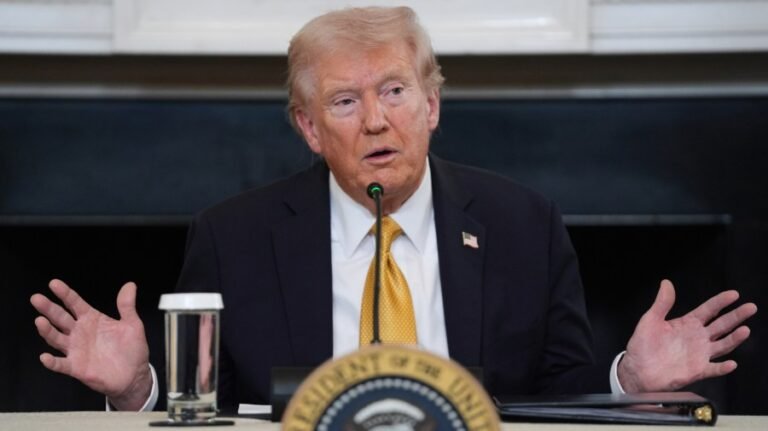
A Republican is actually standing up to President Trump’s threats. Federal Reserve Bank Chairman Jerome Powell, a Republican, isn’t acquiescing to Trump’s demand that the Fed lower its interest rate — or that Powell step down. It’s not something Trump is used to, and he’s clearly displeased.
Even though Trump appointed Powell as the Fed’s chair in 2018, he has lately been very critical. After Powell’s recent comments to the Economic Club of Chicago, Trump wrote on Truth Social: “Jerome Powell of the Fed, who is always TOO LATE AND WRONG, yesterday issued a report which was another, and typical, complete ‘mess!’”
Trump is right that there’s a “mess,” but it’s a result of his own ill-conceived and chaotically applied tariffs.
Trump also added, “Too Late should have lowered Interest Rates, like the [European Central Bank], long ago, but he should certainly lower them now. Powell’s termination cannot come fast enough!”
The Hill reports that Trump’s people are now looking for ways to fire Powell. But there are at least three major impediments to getting him out.
First, Powell won’t go easily. Asked about the disagreement, Trump boasted, “If I want him out, he’ll be out real fast. Believe me.” Actually, don’t believe him. Powell, whose appointment as chair ends in May 2026, has pledged to fight his termination.
Any attempt to fire Powell would certainly go to the U.S. Supreme Court, and it’s anybody’s guess how the justices would rule. Trump and his administration are pushing the “unitary executive theory,” claiming that Article II of the Constitution gives the president the power to do pretty much anything he wants within the executive branch — including firing anyone.
However, the Fed has been operating as a quasi-independent agency since 1914. The legislation creating the Fed was passed by Congress and was signed by President Woodrow Wilson. By statute, the chair cannot be removed except for cause. And whether Trump likes it or not, Powell is doing his job.
But even if Trump is successful in firing Powell, that doesn’t mean he can force the Fed to lower interest rates because of a second major impediment.
Second, even if Trump could fire Powell, it probably wouldn’t change the Fed’s behavior. The Fed has 12 voting members. Even though Powell is the public face of the Federal Reserve, he is not the only one. Trump would have to persuade (or threaten?) half of the 12 members of the Fed’s Federal Open Market Committee, which makes the Fed’s policy decisions, to vote to lower the Federal Funds Rate — that is, the interest rate banks charge each other, which influences interest rates in the broader economy.
With the potential for Trump’s tariffs increasing inflation, most committee members seem fairly content with their wait-and-see approach. Thus, removing Powell or naming a different member to chair the committee while leaving Powell would likely gain Trump nothing.
In short, Trump might have to fire even more members of the committee and replace them with like-minded people to get the lower interest rates he’s demanding. And even if he did, the third impediment might stop his efforts — namely that markets and the economy will sink as a consequence.
We saw Trump blink recently when the stock market, U.S. Treasurys and the value of the dollar all fell simultaneously. He paused his “retaliatory tariffs” (which were anything but retaliatory) for 90 days, saying people were getting “a little bit yippy, a little bit afraid.”
If Trump were to fire Powell, the markets would likely throw a similar fit, creating serious economic problems for Trump, investors and the country. If the market tanks, many companies will hold off hiring or expanding and consumers will scale back purchasing — both of which are already happening. This is called the “negative wealth effect.” Instead of feeling wealthier, as when the stock market rises, people feel poorer and act accordingly — which could lead to a recession.
In addition, investors may lose confidence in the economy and flee U.S. Treasurys, as they did recently. The government then must pay higher interest rates to induce investors to buy our debt. And that means more taxpayer money going to interest instead of paying for the functions of government.
Finally, almost all economists are warning that forcing down interest rates at a time when Trump’s tariffs are putting upward pressure on prices would only exacerbate the inflation problem. It’s true that the European Central Bank lowered rates again, but the bank made it clear it was doing so because Trump’s tariffs threaten a global economic slowdown.
The Fed is facing the opposite problem: Trump’s tariffs forcing prices up. If prices start rising again, voters will hold Trump and Republicans accountable — just as they did former President Joe Biden and Democrats.
Some have suggested that Trump’s threat is just a way to blame Powell if the economy continues to wobble. Maybe so. But if Trump succeeds in ousting Powell and the economy tanks, there will be only one person left to blame.
Merrill Matthews is a public policy and political analyst and the co-author of “On the Edge: America Faces the Entitlements Cliff.”


